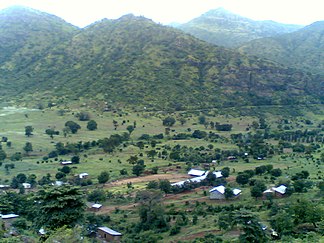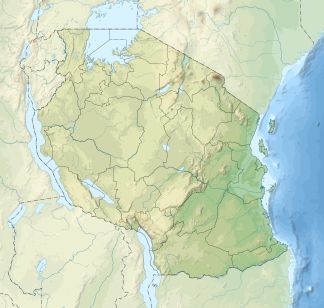Usambara Mountains
| Usambara Mountains | ||
|---|---|---|
|
Mombo at the foot of the Usambara Mountains |
||
| Highest peak | Sungwi ( 2327 m ) | |
| location | Tanzania | |
|
|
||
| Coordinates | 4 ° 43 ′ S , 38 ° 14 ′ E | |
The Usambara Mountains are located in northeastern Tanzania . They belong to the mountain range of the Eastern Arc Mountains , whose rocks were formed in the late Precambrian . They are a refuge of tropical rainforests that have existed for about 30 million years. The Usambara Mountains are among the most biodiverse regions in the world and are home to numerous endemics .
The wide river valley of the Luengera / Lwengera separates the East Usambara Mountains (max. 1506 m) and the West Usambara Mountains (max. 2290 m) from each other.
geography

The Usambara Mountains are located in northeastern Tanzania , not far from the coast of the Indian Ocean and the border with Kenya in the Tanga region . The valley of the Luengera / Lwengera River separates the smaller East from the much larger West Usambara Mountains. Both sub-areas are partly still covered with remnants of very old (> 30 million years) forests and are of outstanding importance for nature and species protection.
The East Usambara Mountains have a size of almost 130,000 hectares and are therefore one of the smaller mountains in Tanzania. They are 150–1506 m high, their main ridge runs from north to south. They are not far from the coast (35 km) and receive an average of 2000 mm of precipitation per year. Their main town is Amani , they are mainly part of the Muheza district and some of the Korogwe district .
The West Usambara Mountains encompass heights of 800–2290 m (other sources call max. 2200–2440 m) and run from southeast to northwest. Its main town is the district capital Lushoto (Eng. "Wilhelmstal"), most of the West Usambara Mountains are in the Lushoto district .
The highest peak of the West Usambara Mountains is the Sungwi at 2290 m (?) , The eastern Usambara Mountains reach their highest point on the Nilo ( 4 ° 52 ′ S , 38 ° 39 ′ E ) at 1506 m. Approximately 900 square kilometers of the Eastern Usambara Mountains are a UNESCO - Biosphere Reserve since 2000 on the list of World Commission on Protected Areas (WCPA) .
history
The Usambara Mountains are part of the Eastern Arc Mountains, the rocks of which are early Precambrian (approx. 600 million years old). The crystalline rock that occurs is deeply furrowed by erosion processes and forms steep slopes.
The first indications of human settlement in the Usambara Mountains come from the Stone to Iron Ages . About 2000 years ago, Bantu migrated from the Congo Basin and mingled with the original inhabitants to form the Shambaa people, the inhabitants of what is now the Usambara Mountains.
Little is known about the history of the Shambaa until the 17th / early 18th centuries.
The lore begins with King Mbega, a successful hunter originally from the Nguru Mountains who settled in Kilinidi. The people asked him for help against a wild boar plague. As a thank you for his support and because of his wisdom, Mbega was chosen as king by the people, the Kilindi family from now on provided the royal family. Vuga, located in Bergen, was designated as the capital.
Mbega merged the ethnic mix of the Usambara Mountains into one strong nation. His grandson Kinyashi built more stable political and military structures and secured the kingdom despite increasing conflicts with neighboring tribes. Under his son Kimweri, the "Simba Mwene" (Lion King), the Shambaa rose to become the most powerful people between Zanzibar and the kingdoms in the Great Lakes region. European researchers such as B. Johann Ludwig Krapf (1848, 1852) as well as Burton and Speke (1857) met and described King Kimweri. Kimweri died in 1862 without a legal successor, and his distant relative Zemboja claimed the throne. He successfully resisted all attempts by the Germans to annex the country. Only after the Bushiri uprising and after paying a generous monthly salary could these Semboja take their side, after his death in 1895 the German colonists took the Usambara Mountains.
In the cool and malaria-free mountain climate, large farms, plantations and numerous mission stations were established during the German colonial era , including Hohenfriedeberg / Mlalo . The jungle was cleared to a large extent for this and for wood production. Lushoto was expanded as "Wilhelmstal" to a popular summer resort and was also discussed as the capital. In Wugiri a height Sanatorium (1904), in the southern part of the mountains at originated Amani an agricultural research institute ( Biological-Agricultural Institute , 1902) with the botanical garden . 1899–1912 the Usambara Railway was built from Tanga to Moshi .
Under the mandate of Great Britain via Tanganyika (until 1961) the road (Tanga-Moshi) was laid out and the rail connection was discontinued. The jungle continued to be cleared to enlarge the plantations, until the 1980s there was a sawmill in the Eastern Usambara Mountains, co-financed by the Finnish government. Finland later got involved in the protection and research of the habitat, e.g. B. in the establishment of the Amani Forest Reserve. In both the Eastern and Western Usambara Mountains there are initiatives today to promote green tourism .
Flora and fauna
The very old (rain) forests of the Usambara Mountains have existed for millions of years and are extremely species-rich. Many plant and animal species are endemic (only to be found here) or almost endemic (mostly restricted to [some] Eastern Arc Mountains or mountain forests in general), some species also occur only in the East or only in the West Usambara Mountains or individual forests in front.
The best-known endemic species is the African violet , furthermore at least 16 tree, 55 snail , 14 lizard and 31 Diplopoda species are endemic to the Usambara Mountains.
In particular, the forests of the East Usambara Mountains are of outstanding importance for the conservation of global biodiversity: They are home to at least 7 strictly endemic vertebrates and 28 other vertebrates, which are restricted to forests in the Eastern Arc Mountains. 40 tree species only grow in the Eastern Arc Mountains. Both the mountain and the subsequent lower-lying forests are of high biological value.
The West Usambara Mountains are home to at least 5 strictly endemic vertebrate species, plus 19 other species that can only be found in the Eastern Arc Mountains.
Some selected species of the Usambara Mountains:
Endemic species:
- African violets
- Usambara annon (extinct tree species in the 20th century)
Almost endemic species (e.g. species of the mountain forests of East Africa, Eastern Arc Mountains, mountains near the coast):
- Usambara Eagle Owl ( Bubo vosseleri )
- Sokoke scops owl ( Otus ireneae )
- Nicoll Weber ( Ploceus nicolli )
- Green forest climber frog
- the stubby- tailed chameleon species Rieppeleon brevicaudatus
More common species, whose terra typica is in the Usambara Mountains:
- Red Usambara Tarantula ( Pterinochilus murinus )
- the Afro yellow wood species Afrocarpus usambarensis
Individual evidence
- ↑ a b c d e f g The Eastern Arc Mountains. ( February 28, 2009 memento in Internet Archive ) Eastern Arc Mountains Conservation Endowment Fund, Tanzania. Retrieved January 11, 2011.
- ^ A b W. A. Rodgers, KM Homewood: Species richness and endemism in the Usambara mountain forests, Tanzania. In: Biological Journal of the Linnean Society. 18, 1982, pp. 197-242.
- ↑ a b c d e Important Bird Areas in Tanzania. (PDF; 3.4 MB) from: birdlife.org , accessed January 20, 2011.
- ^ A b c d Daniela Eiletz-Kaube, Kurt Kaube: Tanzania. Stefan Loose Travel Manuals. DuMont, Ostfildern 2008, ISBN 978-3-7701-6171-3 .
- ↑ Sungwi. at: travelingluck.com
- ↑ Nilo. at: travelingluck.com
- ↑ WCMA entry ( page can no longer be accessed , search in web archives ) Info: The link was automatically marked as defective. Please check the link according to the instructions and then remove this notice.
- ^ PKT Munishi, TH Shear, T. Wentworth, RAPC Temu: Compositional gradients of plant communities in submontane rainforests of Eastern Tanzania. ( Memento of the original from January 1, 2011 in the Internet Archive ) Info: The archive link was inserted automatically and has not yet been checked. Please check the original and archive link according to the instructions and then remove this notice. (PDF; 1016 kB) In: Journal of Tropical Forest Science. 19, 2007, pp. 35-45.
- ^ Annabel Skinner: Tanzania and Zanzibar. Cadogan Guides, London 2005, ISBN 1-86011-216-1 , pp. 182-184.
- ↑ Avibase, English name Usambara Weaver
Web links
- Botanical Research Institute at Amani ( Memento from December 26, 2015 in the web archive archive.today )
- Amani Nature Reserve - an introduction (PDF; 381 kB)
- Original map from Usambara. After recordings during the Dr. Hans Meyer's expedition of 1888.



